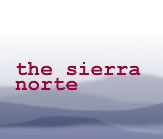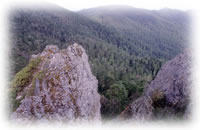 |
 |
||
 |
|||
|
RELATED THEMES development employment and income environment OTHER LOCAL THEMES BACKGROUND |
forestry
Narrators talk of forest exploitation and management, and the degree of organisation that is, or is not, in place to achieve sustainability. Pine is the principal (though not only) species for exploitation, as an elderly resident of Ixtepeji describes: "The most preferred one was the pine, because it was better to cut, and the oyamel (type of pine), which we didn't call oyamel then, we called it pinabete (Zapotec term for oyamel). In those times, when the paper mill came here, we knew the name of oyamel, not pinabete, and the one we called gretado (Cupressus lindleyi), a tree with shorter leaves like the pine.now we call that yacahuite. It is a very soft wood to cut and to split, we split that very well" (Mexico 21). The same narrator explains that pine was used to provide wood for building: ".we used it to build our little homes. There were two classes of tejamanil (traditional rough pinewood planks): the one which was from here for the community, they called tejamanil de piedra (literally, planks of stone), because it was thicker and wider, and the one which was sold in the city was thinner and narrower". He also comments on the absence of controls and management in the past: ".then we didn't hear about the forestry law, because we could cut trees everywhere, and a lot of wood was wasted because the person who cut tejamanil, he took a sample, he cut down the tree, and if it was not good the tree stayed down, and it was lost because it wasn't good for anything". A number of big forestry concessions, granted to companies from outside the Sierra, have reached the end of their term, so that forest possession and management has reverted to local communities. For example in the area around Ixtlán: ".the company took its people out and lost the areas where they were cutting and the villages started taking back their forest. That's why they now sell from the village to the factory; now the long wood is sold to the sawmills - they sell it as it is, they don't work it, it's done in the sawmill instead. There was a union for the communities when the sawmill was established. There was Ixtlán, Calpulalpam, Xiacui and La Trinidad and they called it 'Ixcacit' because of these names, but I don't think that it worked out.[three communities left] and they left Ixtlán alone. Each one took its land to work it in its own way" (Mexico 11). Ixtlán's extensive forests are managed by a substantial community forestry enterprise which is making more active efforts to balance forestry exploitation and conservation: "[In the past].we have only thought about exploiting the forest, but we also have to think that it's a heritage which our forefathers left us and we must be responsible and leave something for our children, for the future generations. this awareness has been developed over the last 10-15 years and now that there is a programme of harvesting our forest, it is being regulated. So.we are taking more care when we cut down a tree not to cause unnecessary destruction. Also the land clearing that we members of the community do to sow crops, sometimes we just planted for one year or two years and then we cleared some more land and caused more destruction - we didn't make full use of everything as we should have done. I think that that is why there was a lot of destruction before, especially when the Tuxtepec paper mill (which had the logging concession in the forests surrounding various communities in the Sierra Norte for about 25 years) was here, but now that it is our responsibility, as commoners, we are taking better care of our forests. There definitely isn't the destruction now that occurred before" (Mexico 15). In the valley which Tiltepec shares with its recently arrived neighbour, the village of La Luz, there is concern that unplanned and uncontrolled felling of old-growth forests will cause changes which will be difficult to reverse: ""Everything has changed now because now we're cutting down the old forests to be able to sow [crops], and in that way we are destroying our forest . it'll take us years to recover again.We shouldn't kill so many trees that have existed for hundreds of years.the same ones won't grow back but different ones. and that's very bad" (Mexico 3). A "vigilance committee" is being set up in Tiltepec to prevent logging in certain designated areas of community territory otherwise, says one man, "what will we leave for our children? .it's necessary to appoint a committee to.be able to keep watch on the forest" (Mexico 9). One woman (Mexico 19) explains how people in Tiltepec retain family plots for firewood for cooking: ".everybody has their piece of land here, close to the village, and they cut little sticks that are dry to bring them back here. for firewood." In Ixtepeji, uncontrolled harvesting of aile ("eagle wood") for production of small wood products (such as molinillos, whisks for making chocolate drink) is fast depleting the species. Local artisans (Mexico 23) are aware that the community needs to organise itself so as to actively manage this situation: ".I talked to one from the comisariado (the office responsible for community property).about what possibilities there were, whether we could reproduce the aile. He said it was a good idea, but we need organisation... [otherwise] each one does what he wants and is able to. He goes and cuts his wood, he doesn't mind whether there will be enough to use later or not.". Thus, although such short-term views exist, many of these narrators seem to be conscious of the need to maintain tree cover, not least to halt the decline of other natural resources too. And the area's wealth in terms of tree species has also been the spur to the new ecotourism project, providing jobs and income, as one young guide (Mexico 26) explains: "[The project] started when it was discovered that here in the Ixtepeji area there is a type of pine that is not very common; they say, I think, that it is no longer found in all of Mexico, except, I believe that there is also a little in the state of Veracruz. It is called the seudotzuga pine." quotes about forestry"We work mostly with pine, which is more common here. People sometimes .ask us for furniture in other types of wood, for example cedar, mahogany, ganacaxtle ("ear tree"; local term for Enterolobium cyclocarpum). Sometimes we look for [cedar] but.there's almost none left any more." "The studies of the paper mill arrived in 1958 and that's why they began clearing the boundary line and extracting wood. There was a lot of machinery because it was a foreign company, it was from Canada, but a little later it became Mexican, it wasn't Canadian anymore." "Our forefathers were very intelligent to leave us a good heritage, above all the forests; our responsibility is to take care of them and look for alternatives so as not to be satisfying our needs only with the forest." "[Coffee,] it's a big help.I hope that everyone grows more coffee and they won't need to clear the forest. Plant two or three almudes, half a hectare - one hectare, something to help the family.There's no need to open up more [forest] because the coffee helps." "From the community forest of Ixtepeji, because since I am an Ixtepeji comunero (registered community member), I am also a ciudadano (citizen); I have the right to get the wood; and to do that I have to get a permit from the comisariado de bienes comunales (office responsible for community property), to cut the trees and to be able to work" "When I arrived here...about 27 years ago.it rained a lot then. I mean sometimes it could rain for up to 20 days, day and night. We couldn't do anything. My God! It really poured. Well it doesn't rain much now, a night or two and that's it, just two or three days. It's changing now [because of deforestation]." ".our forefathers.were more concerned about looking after the forest; they didn't cut it down, they protected it, unlike us today. Selling it, yes, is good for the money but.I don't believe that the money can make it rain for us, like our forest does." |
|
 The Sierra Norte is home to a wide range of forest types, including pine, oak and "cloud" forests, and the diversity of tree species in close proximity makes these forests globally important. Cloud forests are a type of evergreen mountain forest found in tropical areas, where local conditions cause the vegetation to be in frequent contact with cloud and mist. They are characterised by an abundance of mosses, ferns and orchids on every tree and rock surface. A programme of forest protection and development, led by WWF Oaxaca, is built around supporting local people to continue live in and around the forests in a way which respects and strengthens their way of life.
The Sierra Norte is home to a wide range of forest types, including pine, oak and "cloud" forests, and the diversity of tree species in close proximity makes these forests globally important. Cloud forests are a type of evergreen mountain forest found in tropical areas, where local conditions cause the vegetation to be in frequent contact with cloud and mist. They are characterised by an abundance of mosses, ferns and orchids on every tree and rock surface. A programme of forest protection and development, led by WWF Oaxaca, is built around supporting local people to continue live in and around the forests in a way which respects and strengthens their way of life.